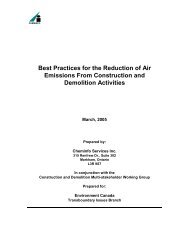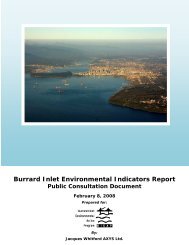Consolidated Environmental Management Plan for Burrard Inlet ...
Consolidated Environmental Management Plan for Burrard Inlet ...
Consolidated Environmental Management Plan for Burrard Inlet ...
Create successful ePaper yourself
Turn your PDF publications into a flip-book with our unique Google optimized e-Paper software.
to conserve a wide range of migratory birds and<br />
their habitats. The Act also prohibits the deposition<br />
of harmful oils, oil wastes or other substances in<br />
waters frequented by migratory birds. In <strong>Burrard</strong><br />
<strong>Inlet</strong>, the Canadian Wildlife Service and the Canadian<br />
Coast Guard oversee wildlife recovery operations<br />
in the event of oil spills. Environment Canada’s<br />
Wetland Conservation and Wildlife Policy <strong>for</strong> Canada<br />
outlines the department’s commitment to conserve<br />
and protect natural habitats within <strong>Burrard</strong> <strong>Inlet</strong>.<br />
Protecting Endangered Species<br />
<strong>Burrard</strong> <strong>Inlet</strong> is home to several endangered or<br />
threatened species. The Province is currently defi ning<br />
habitats to sustain Marbled Murrelet populations<br />
on Crown lands within the <strong>Burrard</strong> <strong>Inlet</strong> and Indian<br />
Arm watersheds and the provincial Spotted Owl<br />
<strong>Management</strong> <strong>Plan</strong> also creates two special resource<br />
management zones to increase the protection of<br />
critical spotted owl habitats within the upper watershed<br />
of the Seymour river. In addition, the Conservation<br />
Area at Maplewood Flats is an important part of the<br />
Pacifi c International Flyway and supports over 200<br />
species of birds and numerous species of wildlife<br />
within 141 ha of land that includes salt and fresh<br />
water marshes, deciduous <strong>for</strong>est, meadow habitats,<br />
shoreline and mudfl ats. This area is home to species<br />
at risk such as the Western Grebe, red listed, the<br />
Great Blue Heron and Double Crested Cormorant,<br />
both blue listed, and the Osprey, yellow listed.<br />
The federal Species at Risk Act has also created<br />
a role <strong>for</strong> Environment Canada and Fisheries<br />
and Oceans Canada in managing endangered<br />
species, recovery planning and implementation.<br />
Maintaining and Enhancing<br />
Biodiversity<br />
While most of the natural shoreline of <strong>Burrard</strong> <strong>Inlet</strong><br />
has been lost to development over the last 100 years,<br />
there still remains a vast <strong>for</strong>ested drainage basin that<br />
extends well into the northern upper mountain slopes<br />
and valleys. Extending upwards of 70 km inland,<br />
these <strong>for</strong>ested and undeveloped watersheds provide<br />
the region with valuable wildlife habitat, recreational<br />
opportunities and two large drinking water reservoirs.<br />
A key component <strong>for</strong> maintaining biodiversity within<br />
the region are the lands designated Conservation<br />
and Recreation in Metro Vancouver’s Regional Growth<br />
Strategy. These lands were established in addition to<br />
an Urban Containment Boundary collaboration with<br />
member municipalities who have also identifi ed and<br />
designated the ecologically signifi cant areas within their<br />
boundaries through their respective Offi cial Community<br />
<strong>Plan</strong>s to limit urban growth and protect these areas.<br />
Conservation and Recreation lands are designed<br />
to protect fi sh and wildlife habitat, improve the<br />
region’s ecological viability and provide recreational<br />
opportunities. The area also supports ecological<br />
linkages or wildlife corridors through developed portions<br />
of the <strong>Inlet</strong>. Conservation and Recreation lands in<br />
<strong>Burrard</strong> <strong>Inlet</strong> include:<br />
• Community health lands, such as Metro Vancouver<br />
drinking-water watersheds and agricultural lands;<br />
• Ecologically important lands, such as <strong>for</strong>ests,<br />
wilderness areas, wildlife habitat and wetlands;<br />
• Outdoor recreation and scenic lands, such as major<br />
parks and recreation areas, and<br />
• Renewable resource lands such as <strong>for</strong>ests and<br />
agricultural areas.<br />
Approximately 70 percent of the <strong>Burrard</strong> <strong>Inlet</strong><br />
ecosystem is located within the Conservation and<br />
Recreation designation. These lands include:<br />
• The North Shore mountains and watersheds (i.e.,<br />
Seymour and Capilano watersheds);<br />
• The Lower Seymour Conservation Reserve;<br />
• Major provincial parks (i.e., Cypress, Mount Seymour,<br />
Twin Isles, Indian Arm and Indian Arm Marine<br />
Provincial Parks), and<br />
• Regional parks (i.e., Pacifi c Spirit, Belcarra, and Lynn<br />
Headwaters Regional Parks).<br />
19<br />
Existing Policy and <strong>Plan</strong>ning Initiatives in <strong>Burrard</strong> <strong>Inlet</strong> / <strong>Consolidated</strong> <strong>Environmental</strong> <strong>Management</strong> <strong>Plan</strong> <strong>for</strong> <strong>Burrard</strong> <strong>Inlet</strong>
















